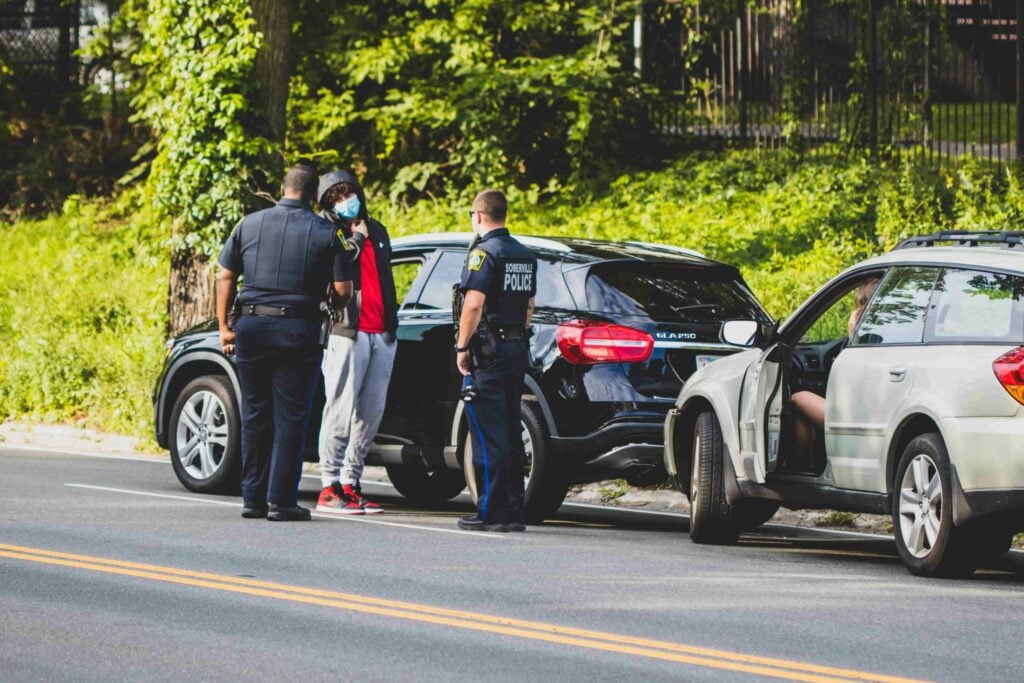In the bustling streets of Pennsylvania, where pedestrians and vehicles share the road, ensuring pedestrian safety is a top priority. This guide will equip you with the knowledge you need to stay safe while walking the Keystone State’s roadways. We’ll cover Pennsylvania pedestrian laws, essential pedestrian safety tips, and explain how our experienced attorneys can assist you in pedestrian accident situations.
Pennsylvania Pedestrian Laws
Understanding Pennsylvania pedestrian laws is important to ensure your safety as a pedestrian. This ensures that you know your rights and responsibilities when walking on public roadways. Some key points to remember include:
1. Right of Way. In Pennsylvania, pedestrians have the right of way when they are in a marked or unmarked crosswalk, at an intersection, or at any lawful pedestrian crossing. Vehicles are required by law to yield to pedestrians in these situations.
2. Pedestrian Signals. Always obey pedestrian signals, such as “Walk” and “Don’t Walk” signs. These signals dictate when it’s safe to cross the road.
3. Jaywalking. Avoid jaywalking, as it can be hazardous and against the law. Use designated crosswalks and pedestrian signals whenever possible.
4. Sidewalks and Shoulders. Whenever available, pedestrians should use sidewalks and pedestrian accommodations. If there are no sidewalks, pedestrians should walk on the left side of the road facing oncoming traffic.
5. Be Visible. Make yourself as visible as possible, especially in low-light conditions. Wear bright or reflective clothing, and carry a flashlight when walking at night.
Use of Sidewalks Under PA Rules of the Road
The use of sidewalks by pedestrians is an essential aspect of road safety. Understanding the rules and regulations governing sidewalk use in Pennsylvania is important for both pedestrians and drivers. Here, we explore the Pennsylvania Rules of the Road in relation to the use of sidewalks.
Pedestrian Use of Sidewalks
Pennsylvania law emphasizes the importance of pedestrian safety and the use of sidewalks. According to the Pennsylvania Consolidated Statutes Title 75, Section 3543, pedestrians are generally required to use sidewalks where provided:
(a) If you’re walking across a road anywhere other than at a crosswalk or intersection with crosswalk markings, you must let vehicles on the road go first.
(b) If there’s a special pedestrian tunnel or overhead crossing, you still need to let vehicles on the road pass before you can cross.
(c) In cities, between traffic signal-controlled intersections, pedestrians should only cross at marked crosswalks, not anywhere else.
(d) You can only cross a road diagonally (at an angle) at an intersection when traffic lights or signs allow it, or when a police officer or someone in charge of traffic tells you to do so. And when you cross diagonally, you must follow the crossing signals.
While pedestrians have the right to use the roadway in certain situations, they must yield the right-of-way to vehicles on the roadway. Pedestrians should exercise caution and be aware of their surroundings to ensure safety.
It’s important for both pedestrians and drivers to be aware of these rules and regulations. Pedestrians should use sidewalks where available. When not provided, walk on the left side of the roadway facing oncoming traffic. Drivers should be vigilant and expect to encounter pedestrians walking on the left side in areas without sidewalks.
Pedestrian Safety Tips
Enhance your safety as a pedestrian by following these essential tips:
- Stay Alert. Pay attention to your surroundings and avoid distractions such as texting or talking on the phone while walking.
- Cross with Caution. Always look left, right, and left again before crossing the road. Make eye contact with drivers to ensure they see you.
- Avoid Rushing. Take your time when crossing. Never attempt to outrun an approaching vehicle.
- Use Crosswalks. Whenever possible, use designated crosswalks and pedestrian signals to cross the road safely.
- Walk Facing Traffic. If there are no sidewalks, walk on the side of the road facing oncoming traffic so you can see vehicles approaching.
- Be Mindful of Intersections. Most pedestrian accidents occur at intersections. Exercise caution and be aware of turning vehicles.
Navigating Traffic Laws for Pedestrian Safety
To protect yourself from pedestrian accidents, it’s essential to understand and follow traffic laws. GSAS is here to emphasize the importance of these laws in ensuring pedestrian safety:
1. Yield to Pedestrians. If you are a driver, always yield the right of way to pedestrians in crosswalks and at intersections. Failing to do so can result in legal consequences.
2. Stop for School Buses. When a school bus is stopped with red lights flashing and the stop arm extended, all traffic must stop. This applies to drivers from all directions.
3. Reduce Speed. In areas with heavy pedestrian traffic, slow down and be prepared to stop quickly.
4. No Passing Stopped Vehicles. It’s illegal for drivers to pass a vehicle stopped at a crosswalk to allow pedestrians to cross.
5. Obey Traffic Signals. Always stop at red lights and stop signs, even if there are no pedestrians present. This ensures safety for all.
Dealing with the Law: When You Are Injured or Injure Someone
If you are involved in a pedestrian accident situation, it’s crucial to understand how to deal with the law. Spivak & Sakellariou (GSAS) is here to guide you through these challenging situations.
If You Get Injured
a. Seek Medical Attention: Your health is the top priority. If you are injured as a pedestrian, promptly seek medical attention, even if your injuries seem minor. It’s essential to document your injuries, as this will be crucial in legal proceedings.
b. Gather Information: If you are physically able, collect information at the accident scene. This includes the names and contact details of any witnesses, as well as the driver’s information, vehicle details, and insurance details.
c. Consult with an Attorney: Reach out to an experienced Pennsylvania pedestrian accident attorney, such as GSAS. We can help you understand your legal rights and options, guide you through the process, and work with you to secure fair compensation under Pennsylvania law.
d. Preserve Evidence: Keep all documents and evidence related to the accident, such as medical records, photos of the scene, and any correspondence with the other party’s insurance company. These can be valuable when making a claim.
e. Understand Insurance Coverage: Pennsylvania is a no-fault insurance state. This means that, if you’re in a car accident, both you and the other person involved in the accident need to ask your own insurance companies to pay for your lost wages and medical bills. It doesn’t matter who is at fault for the accident. Your insurance takes care of your expenses, and the other person’s insurance covers their expenses. GSAS attorneys can help you navigate this complex system.
If You Injure Someone
a. Stay at the Scene: If you are involved in an accident where you have injured a pedestrian, remain at the scene. Fleeing can lead to serious legal consequences.
b. Provide Aid: Assist the injured pedestrian as much as you can, including calling 911 for immediate medical attention if necessary. Your actions can make a significant difference in their recovery.
c. Cooperate with Law Enforcement: When the police arrive, provide an accurate account of the accident. Your statement can be crucial in determining liability.
d. Do Not Admit Fault: While it’s essential to cooperate, avoid admitting fault at the scene. The responsibility for the accident will be determined through a thorough investigation.
e. Consult with an Attorney: Even if you believe the accident was not your fault, it’s advisable to consult with an attorney to understand your rights and potential legal obligations. GSAS can help you navigate the legal process and protect your interests.
f. Contact Your Insurance Company: Report the accident to your insurance company promptly, even if you believe you were not at fault. They can guide you through the claims process.
Understanding Title 75: Pedestrian Right-of-Way in Pennsylvania
Title 75 of the Pennsylvania Consolidated Statutes, the comprehensive body of laws governing transportation in the state, contains essential provisions related to pedestrian safety and the right-of-way for pedestrians. One such provision, § 3542, focuses on the right-of-way of pedestrians in crosswalks.
§ 3542. Right-of-way of Pedestrians in Crosswalks Explained
(a) General Rule: When traffic-control signals are not in place or not in operation, the driver of a vehicle shall yield the right-of-way to a pedestrian crossing the roadway within any marked crosswalk or within any unmarked crosswalk at an intersection.
This section establishes a clear rule that emphasizes the importance of pedestrian safety. It places a legal obligation on drivers to yield the right-of-way to pedestrians when they are crossing the roadway within a crosswalk. This rule applies in situations where traffic signals are not controlling the intersection or are not operational.
(b) Exercise of Care by Pedestrian: No pedestrian shall suddenly leave a curb or other place of safety and walk or run into the path of a vehicle, which is so close as to constitute a hazard.
This subsection underscores the shared responsibility between pedestrians and drivers in ensuring safety. Pedestrians are also expected to exercise caution and not put themselves in harm’s way by suddenly entering the path of a vehicle that is too close for safety.
(c) Limitation on Vehicles Passing: Whenever any vehicle is stopped at any crosswalk at an intersection or at any marked crosswalk to permit a pedestrian to cross the roadway, the driver of any other vehicle approaching from the rear shall not overtake and pass the stopped vehicle.
This provision highlights the requirement for drivers to remain patient when a vehicle is stopped at a crosswalk to allow a pedestrian to cross. It prohibits other drivers from overtaking and passing the stopped vehicle, ensuring the safety of the pedestrian.
(d) Application of Section: Subsection (a) does not apply under the conditions stated in section 3543(b) (relating to pedestrians crossing at other than crosswalks).
This subsection states that the rules in subsection (a), which talk about pedestrians crossing the road at places other than crosswalks, don’t apply when certain conditions mentioned in section 3543(b) are met. In other words, when the conditions described in 3543(b) are met, the rules in subsection (a) about pedestrians yielding to vehicles don’t need to be followed.
(e) Penalties: The driver of a vehicle who violates subsection (a) commits a summary offense and shall, upon conviction, be sentenced to pay a fine of $50.
This subsection establishes the legal penalties for drivers who fail to yield the right-of-way to pedestrians in crosswalks as required by subsection (a). Violating this section results in a summary offense and carries a fine of $50 upon conviction.
Title 75 of the Pennsylvania Consolidated Statutes, including § 3542, is crucial in upholding pedestrian safety and defining the legal obligations of both pedestrians and drivers in the state. It serves as a cornerstone for ensuring that all individuals on Pennsylvania roadways can navigate safely and confidently. Spivak & Sakellariou (GSAS) is dedicated to assisting individuals to understand and apply these laws when addressing pedestrian safety and accident cases.
GSAS Attorneys Are Here to Help
In situations where pedestrian accidents occur, knowledgeable attorneys at Spivak & Sakellariou (GSAS) can provide invaluable assistance. We are committed to helping accident victims navigate the legal complexities, ensuring they receive the support they deserve. Whether it’s pursuing a personal injury claim, seeking justice, or addressing liability issues, our legal insight can guide you through the process. Your safety and legal rights are our top priorities.
By familiarizing yourself with Pennsylvania pedestrian laws, implementing pedestrian safety tips, and understanding how to navigate traffic laws, you can significantly reduce the risk of pedestrian accidents. Prioritizing pedestrian safety is a responsibility that GSAS is dedicated to supporting, in terms of safety guidance and legal assistance when needed. Vigilance, respect for the rules of the road, and skilled legal support are essential for ensuring safe pedestrian journeys in the Keystone State.


